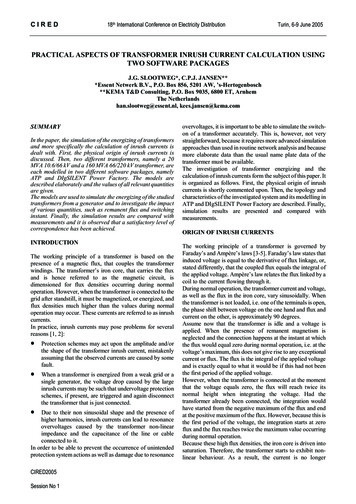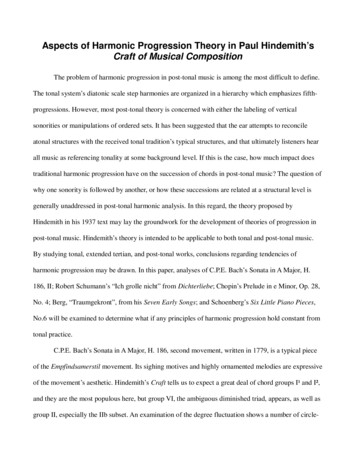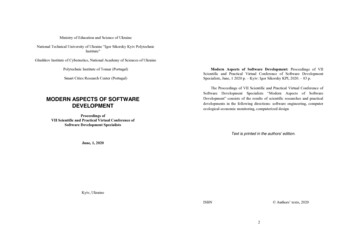
Transcription
CENTRAL EUROPEAN BUSINESS REVIEWRESEARCH PAPERSVOLUME 2, NUMBER 1 , MARCH 2013STRATEGY AND PORTFOLIO MANAGEMENT ASPECTSOF INTEGRATED BUSINESS PLANNINGJurečka, P.With ongoing globalization and the resulting growing competitiveness on most markets, companies are under constantpressure to increase the effectiveness and efficiencies of their operations. The focus of this paper is placed on oneof the core business management processes – on planning, namely on Sales and Operations Planning (S&OP) andits latest development stage, nowadays often recognized under the term Integrated Business Planning (IBP). Theauthor’s experience from leading the global implementation of IBP in a multinational chemical company is reflected inthe proposition of how IBP can serve as an effective tool for execution of business strategy. The article further illustrateshow different generic strategies and product portfolio models of the companies impact the set-up of an IBP process. Asthe IBP concept is applicable for almost all businesses and markets, it can be used broadly as an effective tool for facingthe challenges of economic and financial crisis.JEL Classification: M11, G17, L2Keywords: portfolio management; integrated business planningIntroductionThroughout the past decades, challenges brought byongoing globalization of the economy and rising competitive pressures forced companies to abandon the traditionalview of independent and often poorly aligned planningprocesses, executed separately by different business functions. Although the first concepts of structured productionplanning appeared as early as in the beginning of 1960s,when Joseph Orlicky studied Toyota’s ManufacturingProgram and developed a Material RequirementsPlanning (MRP) and later MRP II1 (Orlicky, 1975), it wasthe concept of S&OP that came out as a first significantstep forward trying to align planning activities acrossmultiple business functions. Over the last 30 years, S&OPhas gradually evolved into a standard industry practiceand reshaped its content and focus from predominantlyproduction planning to a company-wide managementprocess, recognized today more and more often under theterm Integrated Business Planning (IBP).128Bringing also master scheduling, rough-cut capacity planning, capacity requirements planning and other concepts toclassical MRP.According to consultants from Oliver Wight2, a properlyimplemented IBP process routinely reviews the current andprojected business performance starting with the review ofstrategy and portfolio changes, updated customer demand,required supply resources and resulting financial implications. The traditional view on S&OP, as on the processmerely balancing supply and demand, is thus long obsolete. Oliver Wight also defines several points that differentiate IBP from traditional S&OP, with inclusion of strategicplanning and more robust product and portfolio reviewput at forefront.3 Aberdeen Group researchers further statethat “the key difference between traditional S&OP and IBPis that IBP involves extensive collaboration between thevarious roles of the organization and enables the unification of business goals and strategies rather than just beinga functional supply chain process” (Aberdeen Group, 2008,p. 4). As further noted by Palmatier and Crum, “focus ofattention on S&OP has been shifting towards a better understanding of the external environment as well as ensuring thealignment and synchronization among the internal functions2IBP/S&OP: An executive level synopsis, Oliver Wight whitepaper series, http://www.oliverwight-americas.com3Adopted from Oliver Wight presentation on Integrated Business Planning Summit, IE Group, Zurich, March 2011.
CENTRAL EUROPEAN BUSINESS REVIEWRESEARCH PAPERSVOLUME 2, NUMBER 1 , MARCH 2013Figure 1: Strategy execution according to Kaplan and NortonSource: Kaplan and Norton (2008), p. 8.of the company” (Palmatier and Crum, 2010, p. 3). Theyfurther emphasize that the shift of S&OP toward strategicmanagement as being a key driver in the transition to IBP.To sum-up, structured inclusion of strategic initiatives intooperational management forms one of the key prerequisitesof shifting from traditional S&OP into the state of the artconcept of IBP. The following chapters analyze, in moredetail, three relevant aspects of this shift from the perspective of IBP process set-up – reflection of strategy execution,encounter of generic competitive strategy and inclusion ofportfolio development into operational planning and decision-making processes.IBP as a Tool of Strategy ExecutionIn past decades, lots of improvements have been achievedin the field of development of strategy execution tools.Balanced scorecard has become probably the leadingapproach towards comprehensive management of an organization’s performance, followed by systems based on themanagement of quality (Baldrige Criteria, TQM, six sigma,European foundation for Quality Management, etc.) orfinancial management (economic value added) (Lawson,Desroches and Hatch, 2008).However, despite the existence of a myriad of strategydevelopment and implementation tools, organizations arestill often failing in successful execution of their strategies.According to Kaplan and Norton, strategy execution wasplaced in 1st position in a comprehensive global survey ontop-executives’ priorities. Another study that they conductedabout the state of strategy execution revealed, that ca. 40percent of reviewed organizations still did not have formalsystems to help them execute their strategies; over 70 percentreported average or below average performance of their strategies (Kaplan and Norton, 2008).As a response to issues identified in the surveys mentionedabove, Kaplan and Norton proposed a comprehensive andintegrated management system that links strategy formulationand planning with operational execution as outlined in Figure1. They claim that companies can benefit from taking thisapproach to linking strategy and operations through implementation of the described close-loop management system.The main drawback of such a system is that in most of thecases, implementation of such an extensive approach towardsstrategy execution would require the employees of thecompany to adopt and manage relatively a complex set of initiatives on the top of their current responsibilities. As a result,strategy implementation as a whole might hit resources constraints as well as change management-related hurdles.Subsequent to the author’s experience leading a world-wideimplementation of the IBP concept within a major globalplayer in the chemical industry, I suggest that failing tosuccessfully implement the business strategy may be oftengrounded in insufficient integration, collaboration, communication and incentive setting amongst different businessunits in the “strategy-to-operations” cycle. The underlyingreason for this phenomenon may be the lack of integration and structured cooperation amongst different businessfunctions.29
CENTRAL EUROPEAN BUSINESS REVIEWRESEARCH PAPERSAs a practical example, let us use the missing alignmentbetween multiple IT systems and tools, which are usedto support the planning and reporting processes of Sales,Marketing, R&D, Finance or Operations. Insufficient gapreconciliation between these systems and lack of understanding of the differences between the outcomes of independentplanning processes result in inefficiencies in decision makingand “surprises” for management. For example, Marketing,with a strategic mid-to-long term horizon, commonly endsup isolated from the comprehensive feedback from Sales onhow markets really react to their proposed strategic initiatives.Moreover, Finance – with their strong value orientation – oftenfocuses on the fulfillment of bottom line commitment definedin targets or budgets, with limited interest in the real salesvolumes mix that is on the other hand crucial for Operations– Production and Distribution. The communication silosare not uncommon and incentives across the organizationnot being sufficiently aligned towards common targets. Eachstakeholder of the planning process is not truly motivated forany deeper cooperation with the rest of the organization.The question then is, how to set an effective approachtowards strategy execution, one that would minimally interfere with current “daily” activities of the firm and tasks of theemployees. In other words, how to integrate strategy executioninto existing core management processes so that it becomesan integral part of business operations instead of being theone-off action that is being repeated once in a while when thestrategy is reviewed. The concept of Integrated Business Planningprovides the answer to the abovementioned questions.As IBP is rather a business term without an exact definition, the author defines the following three main aspectsthat could be summarized as key characteristics of IBP oradvanced S&OP.IBP as a Key Platform for Operational Managementof the CompanyIBP should be understood as a key process for operationalmanagement of the company. It should not complement, butreplace the multiple planning processes that are often runningin the business organizations in parallel. Furthermore, itshould not be understood as only “planning”, but mainlyas a management “decision-making” process. The questionof ownership should no longer focus on which individualbusiness function should dominate the process, but rather onhow to orchestrate the efforts of all functions into a singleintegrated process. These go hand in hand with alignment ofincentives and individual target setting.IBP as a Structured Gap Management ProcessContent wise, the IBP process should be established so thatit gradually identifies and manages different types of gaps.30VOLUME 2, NUMBER 1 , MARCH 2013These can be the gaps between various sales demandscenarios, between given budgets or targets and the latestforecasts, between different planning horizons and planning methods applied by individual business functionsor between the level of detail and master-data structureamongst various planning systems. Throughout multiplegap reconciliation rounds within the monthly planningcycle, the organization should develop an integrated“one-number” sales demand forecast. This should reflectthe bottom-up customer view of Sales balanced out withthe top-down strategic view of Marketing. Furthermore, itshould be reviewed from a feasibility perspective by SupplyChain and from a financial value perspective by Finance.On the top, this base case forecast should be accompaniedwith various sales scenarios reflecting different alternativesof underlying assumptions for further business opportunities and risks.IBP as a Linkage Between a Company’s Strategyand OperationsAlignment of different planning processes across the organization and structured management of the gaps between different plans should result in a consensus between top-downstrategy execution and direct bottom up feedback from themarketplace. This approach can be implemented into theplanning philosophy of the firm and thus serve as a constantand sustainable way of executing strategy and monitoring ofits fulfillment.Furthermore, as IBP is aiming primarily for improvementsof one of the core management functions – planning, it canbe implemented into the already existing process structurein the firm. Thus, contrary to some complex strategy implementation systems, it can serve as a relatively easy toachieve, efficient and sustainable way of linking strategywith operations.The following two sections analyze, in more detail, howvarious generic strategies and portfolio models of the firmshould be reflected in the set-up of an IBP process from theperspective of its owner or key decision-making power andrelated structure of key performance management indicators.Set-up of an Integrated Business Planning Process WithRespect to Company’s StrategyOne of the key factors that should be taken into accountwhen deciding about optimal set-up of an IBP processin the firm is the general strategic focus of the company.Porter in his classic work Competitive Strategies identifiesthree main strategic options open to any organization thatwishes to achieve a sustainable competitive advantage asdisplayed on the Figure 2. Adopting Porter’s generic strategy view, three basic IBP set-ups can be derived based onthe following key strategic directions of the company:
businesses. Table 1 summarizes the key elements and characteristics of IBP for each of thegenericstrategies.CENTRAL EUROPEANBUSINESS REVIEWRESEARCH PAPERSTable1: IBPownershipon keystrategicTable1: IBPownershipbased on basedkey strategicfocusVOLUME 2, NUMBER 1 , MARCH 2013focusSource: AuthorSource: AuthorCost leadershipChain had the dominant role in the decision making withinthe S&OP process. The priorities in planning are set to elimi Product differentiationnateIBPthe forecasting bias and improve forecast accuracy. OtherStrategicPortfolio Management Translated into Customer (relationship) focus.critical success factors include discipline in execution andDifferent IBP set-ups reflecting the above mentioned stra- control of operations, elimination of waste, continuous improAsalreadymentioned,portfoliostructuremay havesignificantimplicationsonorganization.how an IBPvementand reductionof layers in theA singletegiesvary fromeach other intheir functionalownershipand emphasis on key focal points as well as in performance set of planning numbers in such an environment representsimportantprerequisiteto achieveefficimeasures thatshould be appliedto steer themwithin corpoprocessis established.Inclusionof theseaspects ndoneencies. Executive leadership in this process is in the hands ofrate performance management system.Operationspossibly itFinance.The main key performanceof the key defining factors of the IBP concept. Withinthisandsection,is demonstratedhowFigure 2: Porter‘s generic strategiesindicators complementing
According to consultants from Oliver Wight2, a properly implemented IBP process routinely reviews the current and projected business performance starting with the review of strategy and portfolio changes, updated customer demand, required supply resources and resulting financial impli-cations. The traditional view on S&OP, as on the process merely balancing supply and demand, is thus long obso .











